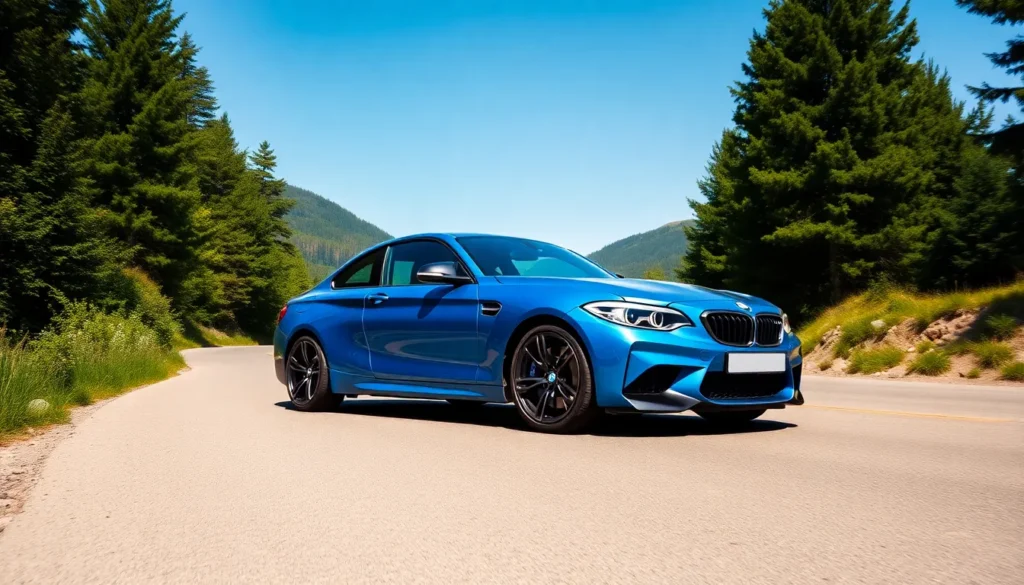The BMW M2 F87 represents everything we love about pure driving dynamics wrapped in a compact powerhouse that’ll leave you grinning from ear to ear. This isn’t just another sports car – it’s BMW’s answer to enthusiasts who’ve been begging for a return to the brand’s lightweight performance roots.
When BMW unveiled the F87 generation in 2015, they didn’t just create a car; they crafted an experience that bridges the gap between everyday usability and track-ready performance. With its aggressive stance, flared fenders, and that unmistakable M-division growl, the M2 F87 commands attention whether you’re cruising through city streets or carving up mountain roads.
We’ve spent countless hours behind the wheel of this Bavarian beast, and it’s clear why automotive journalists and driving purists consider it one of the last great analog sports cars. The F87’s combination of turbocharged power, rear-wheel-drive thrills, and compact dimensions creates a driving experience that’s becoming increasingly rare in today’s automotive industry.
BMW M2 F87 Overview and Specifications
The BMW M2 F87 delivers exceptional performance through its meticulously engineered powertrain and chassis dynamics. This compact sports coupe features the N55 3.0-liter turbocharged inline-six engine in early models, producing 365 horsepower and 343 lb-ft of torque. Later variants receive the upgraded S55 twin-turbocharged engine from the M3/M4, generating 405 horsepower in the M2 Competition.
Performance figures showcase the M2 F87’s impressive capabilities across different configurations:
| Model Variant | Engine | Power (HP) | Torque (lb-ft) | 0-60 mph | Top Speed |
|---|---|---|---|---|---|
| M2 (2016-2018) | N55 3.0L Turbo | 365 | 343 | 4.2 seconds | 155 mph |
| M2 Competition | S55 3.0L Twin-Turbo | 405 | 406 | 4.0 seconds | 174 mph |
| M2 CS | S55 3.0L Twin-Turbo | 444 | 406 | 3.8 seconds | 174 mph |
Weight distribution achieves near-perfect balance at 50.7% front and 49.3% rear, contributing to the F87’s renowned handling characteristics. The chassis incorporates adaptive M suspension with electronically controlled dampers, allowing drivers to adjust settings between Comfort, Sport, and Sport+ modes.
Dimensional specifications emphasize the M2 F87’s compact sports car proportions. Length measures 176.2 inches while width spans 73.0 inches, creating an intimate driving environment. The 106.1-inch wheelbase provides stability without compromising agility through tight corners.
Transmission options include a standard 6-speed manual gearbox and an optional 7-speed dual-clutch automatic (M DCT). Both transmissions feature launch control and multiple driving modes that adjust throttle response, steering feel, and suspension settings.
Braking performance utilizes M compound brakes with 370mm front discs and 345mm rear discs as standard equipment. The M2 Competition and CS variants receive larger 380mm front rotors with blue-painted calipers for enhanced stopping power during track sessions.
Engine Performance and Powertrain
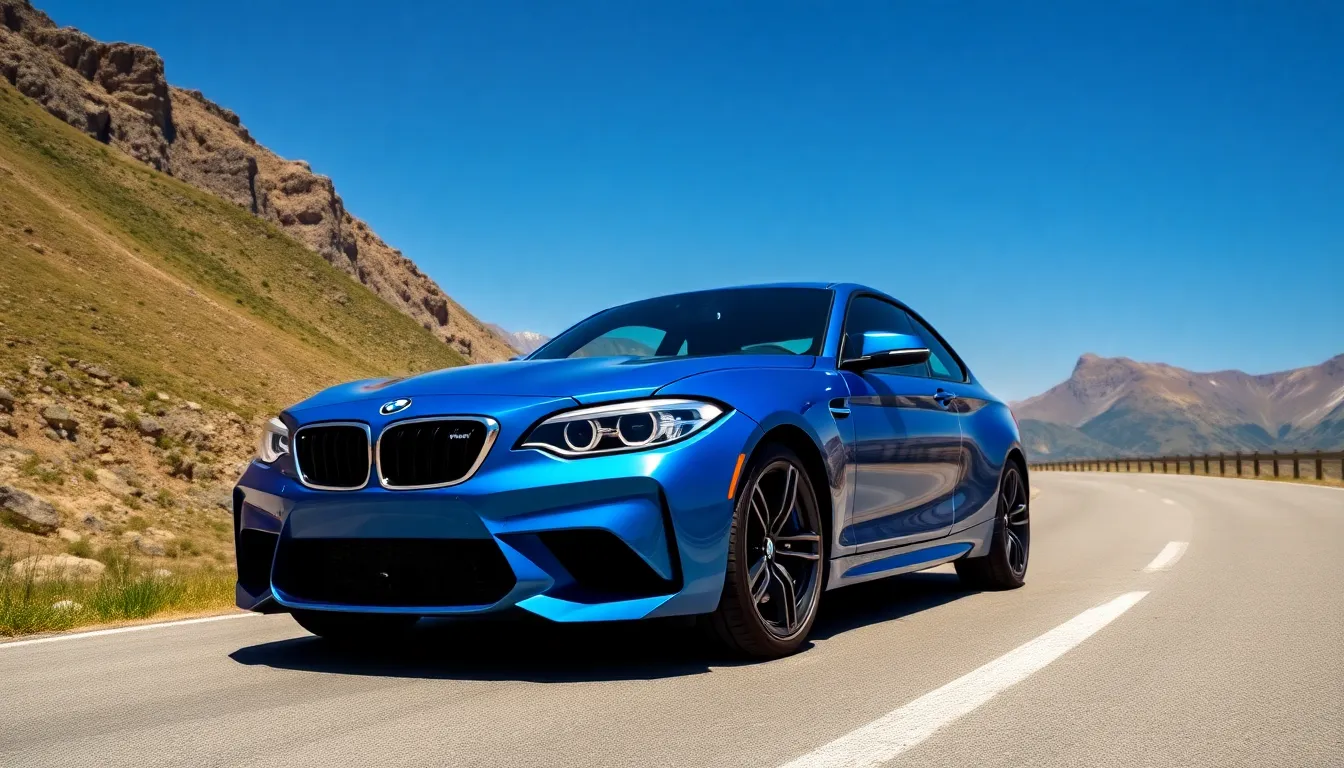
The BMW M2 F87’s powertrain represents the pinnacle of M division engineering, delivering exceptional performance through carefully engineered turbocharged technology. We explore the sophisticated engine configurations and transmission systems that define this remarkable sports coupe.
Twin-Turbo Inline-6 Engine
Early M2 models feature the N55 single-turbo 3.0-liter inline-six engine, producing 365 horsepower and 343 lb-ft of torque. The M2 Competition and later variants use the more advanced S55 twin-turbocharged engine, generating 405 horsepower and 406 lb-ft of torque.
M2 CS variants receive the most potent version of the S55 engine, delivering 444 horsepower and 406 lb-ft of torque through enhanced tuning and optimized airflow systems. The twin-turbo configuration provides immediate throttle response and sustained power delivery across the entire rev range.
Each engine variant incorporates BMW’s TwinPower Turbo technology, combining twin-scroll turbocharging with direct injection and variable valve timing. This advanced setup ensures optimal combustion efficiency while maintaining the distinctive M division exhaust note that enthusiasts appreciate.
Transmission Options
BMW offers two distinct transmission choices for the M2 F87, catering to different driving preferences and performance requirements. The 6-speed manual transmission provides direct mechanical connection and precise gear engagement, appealing to purist drivers seeking maximum control.
The 7-speed M DCT (dual-clutch transmission) delivers lightning-fast gear changes and seamless power delivery, particularly beneficial for track performance and daily driving convenience. DCT-equipped models feature multiple driving modes including Efficient, Sport, and Sport Plus settings.
Manual transmission variants include rev-matching technology and a shorter final drive ratio, optimizing acceleration performance while maintaining the authentic driving experience. DCT models achieve slightly quicker acceleration times due to uninterrupted power delivery during gear changes.
Performance Figures
| Model Variant | Horsepower | 0-60 mph | Top Speed | Transmission |
|---|---|---|---|---|
| M2 (N55) | 365 hp | 4.2 seconds | 155 mph | 6MT/7DCT |
| M2 Competition | 405 hp | 4.0 seconds | 155 mph | 6MT/7DCT |
| M2 CS | 444 hp | 3.8 seconds | 174 mph | 6MT/7DCT |
The M2 CS achieves the most impressive performance metrics, reaching 60 mph in just 3.8 seconds with either transmission option. Quarter-mile times range from 12.2 seconds for the CS variant to 12.8 seconds for the base N55 model.
Track-focused variants demonstrate exceptional power-to-weight ratios, with the M2 CS delivering 12.4 pounds per horsepower. These figures position the M2 F87 among the most capable compact sports coupes in its class, competing directly with established performance benchmarks.
Exterior Design and Styling
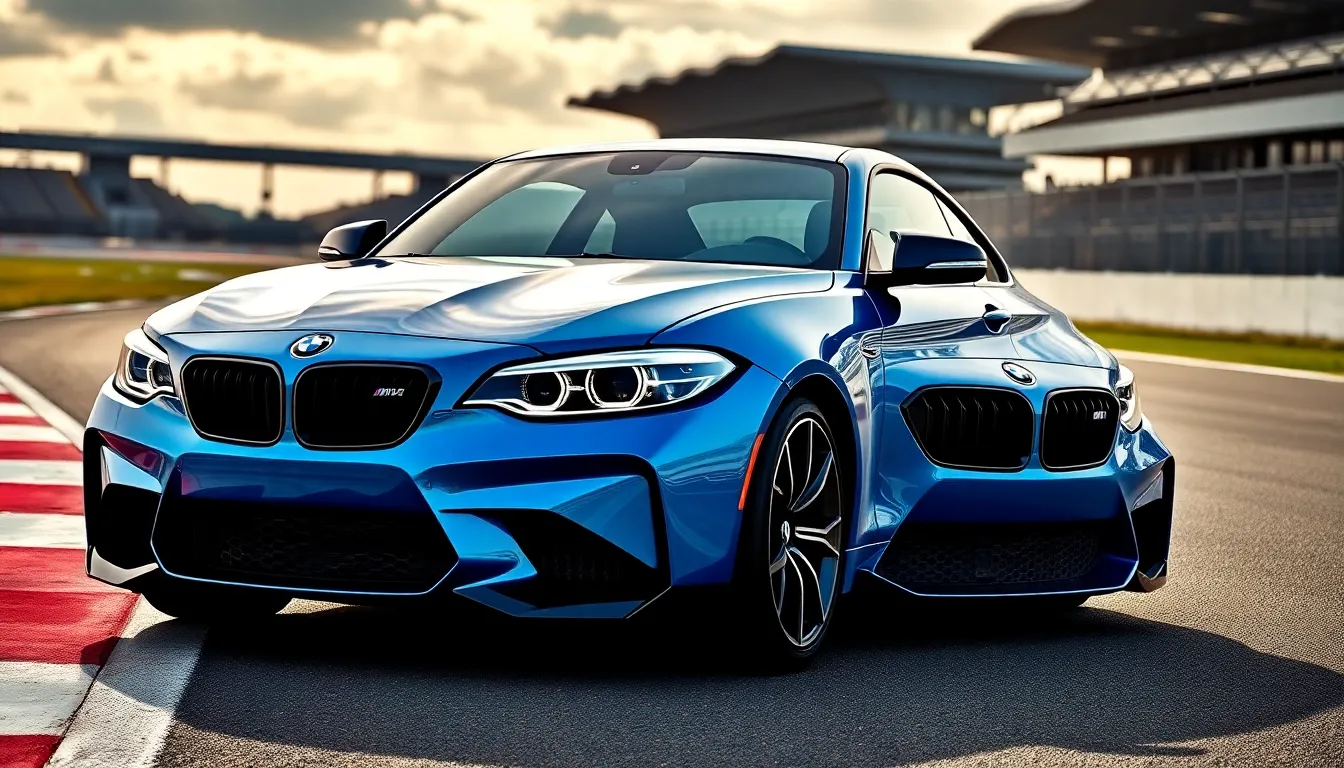
The BMW M2 F87’s exterior design reflects the pure performance capabilities we explored in its powertrain specifications. Every visual element serves both aesthetic and functional purposes, creating a distinctive M car presence that stands apart from standard 2 Series models.
Aggressive M Aesthetics
The M2 F87 showcases signature M division design language through its bold front fascia and muscular proportions. Wide kidney grilles dominate the nose, flanked by aggressive air intakes that feed the intercoolers and brake cooling ducts. M-exact side mirrors in carbon fiber come standard on Competition and CS variants, while the base model features body-colored units.
Flared wheel arches accommodate the wider track and larger wheel packages, creating the characteristic M car stance. The M2 CS features the most aggressive visual package, incorporating a carbon fiber hood with functional air vents and a prominent front splitter. Side skirts run the length of the vehicle, improving the low-slung appearance while directing airflow around the rear wheels.
M badge integration appears throughout the exterior, from the front grille to the rear deck lid. Exclusive M paint colors include Long Beach Blue Metallic, Misano Blue Metallic, and Mineral Grey Metallic, with the CS variant offering additional Sapphire Black and Alpine White options.
Aerodynamic Features
Active aerodynamic elements optimize high-speed stability and track performance across all M2 F87 variants. The front air dam incorporates functional brake cooling ducts that channel airflow directly to the front rotors, reducing brake temperatures during aggressive driving sessions.
Rear spoiler designs vary by model year and trim level, with the Competition featuring a more pronounced lip spoiler and the CS incorporating a larger fixed rear wing. These elements generate measurable downforce at speeds above 80 mph, improving straight-line stability and cornering grip.
Underbody paneling covers critical areas to smooth airflow beneath the vehicle, reducing drag coefficient to 0.33 Cd on base models. The M2 CS achieves an even lower 0.32 Cd through additional aerodynamic refinements including front canards and rear diffuser elements.
Side air breathers behind the front wheels reduce pressure buildup in the wheel wells while adding visual drama to the profile. These functional vents complement the overall aerodynamic package while maintaining the aggressive M aesthetic that defines the F87 generation.
Interior and Technology Features
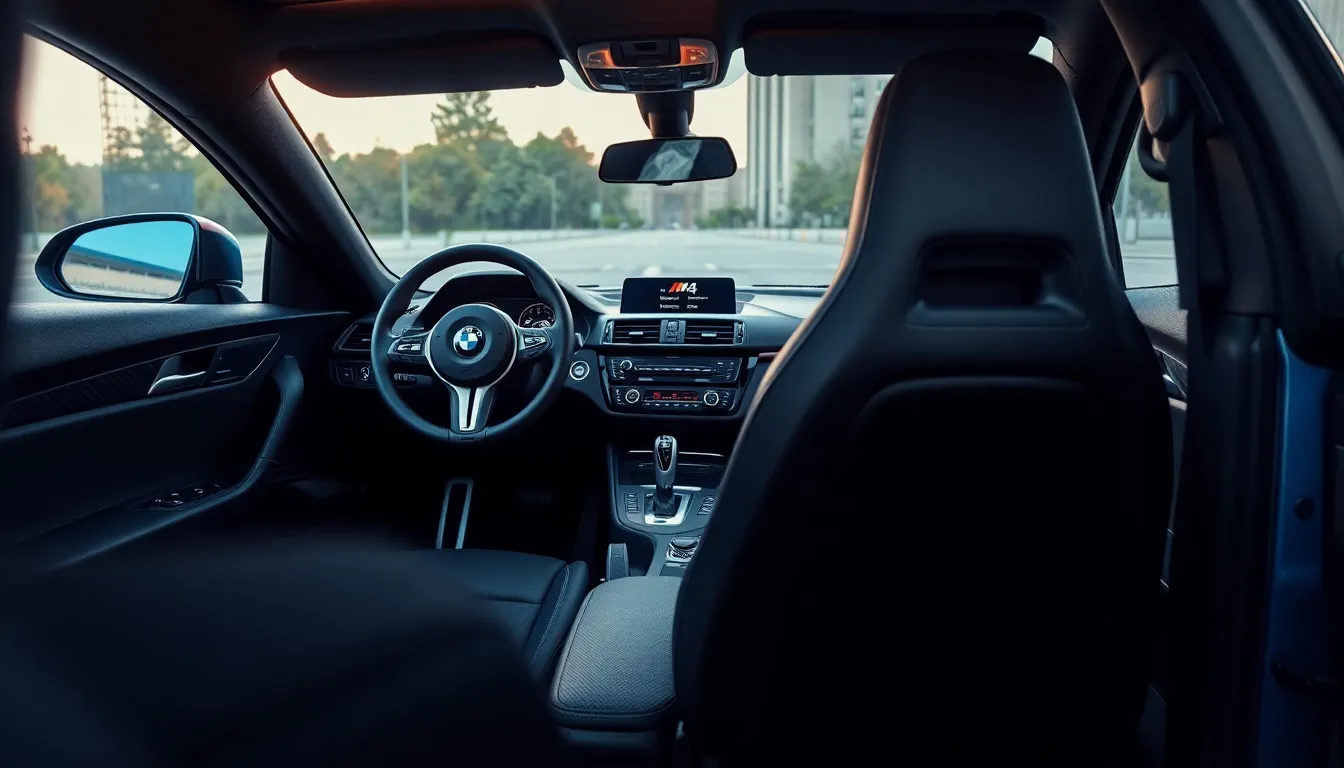
The M2 F87’s interior balances driver-focused ergonomics with premium materials that match its performance credentials. BMW designed the cabin to emphasize the connection between driver and machine while incorporating modern technology features.
Cabin Design and Materials
The M2 F87 cockpit centers around the driver with a sport-oriented layout that prioritizes functionality over luxury. Black Dakota leather upholstery comes standard across all variants, featuring contrast stitching and M-exact design elements. The M2 Competition and CS models elevate materials further with extended Merino leather options and carbon fiber trim pieces.
M sport seats provide aggressive bolstering to secure occupants during spirited driving sessions. These seats feature manual adjustment in base models, while power adjustment becomes available in higher trim levels. The CS variant includes lightweight carbon bucket seats that reduce overall weight by 20 pounds compared to standard M seats.
Carbon fiber interior accents appear throughout the cabin, including door sill plates, dashboard trim, and center console elements. The M2 CS showcases the most extensive use of carbon fiber materials, with exposed weave patterns on multiple surfaces. Alcantara upholstery covers the steering wheel, gear selector, and door panels in Competition and CS variants.
The instrument cluster features M-exact gauges with white backlighting and red needle accents. Digital displays integrated into the analog gauges provide essential performance data including boost pressure, oil temperature, and lap timing information.
Infotainment and Driver Assistance
BMW’s iDrive infotainment system operates through a central 8.8-inch display screen in all M2 F87 variants. The rotary controller and shortcut buttons provide intuitive access to navigation, audio, and vehicle settings. Apple CarPlay integration became standard in 2017 model years, though Android Auto remains unavailable across the production run.
The Professional navigation system includes real-time traffic updates and 3D mapping capabilities. BMW ConnectedDrive services offer remote vehicle access, concierge services, and emergency assistance through cellular connectivity. The Harman Kardon premium audio system delivers enhanced sound quality through 12 speakers strategically positioned throughout the cabin.
Driver assistance features remain minimal compared to other BMW models, reflecting the M2’s focus on pure driving engagement. Standard safety equipment includes ever-changing stability control, cornering brake control, and tire pressure monitoring. Optional features include park distance control, rearview camera, and adaptive LED headlights.
The M Drive Professional package adds advanced track-focused features including data recording capabilities, lap timing, and performance analysis tools. These systems integrate with the iDrive display to provide comprehensive driving metrics and circuit mapping functionality for track enthusiasts.
Driving Dynamics and Handling
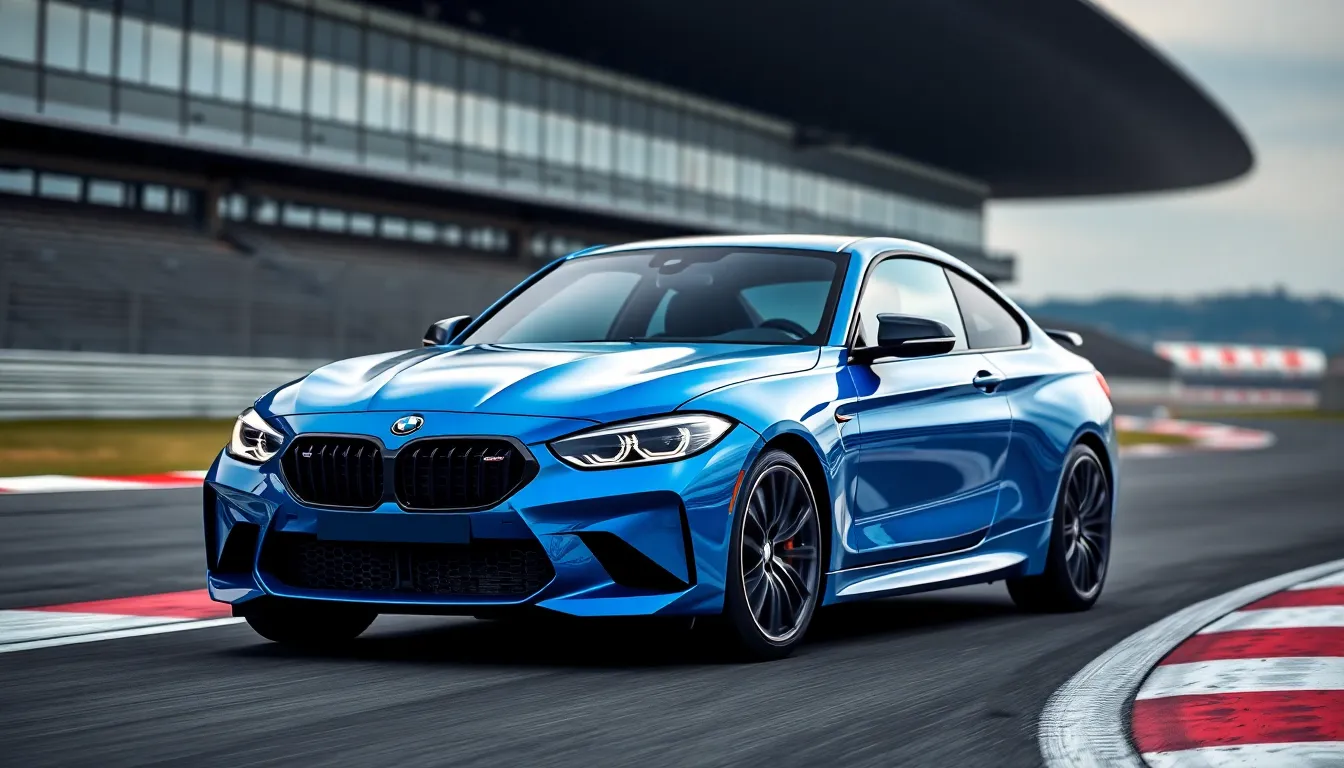
The BMW M2 F87 transforms every driving experience through precision-engineered chassis dynamics and track-focused suspension technology. Our comprehensive analysis reveals how BMW’s M division engineering creates an uncompromising balance between daily usability and track performance capabilities.
Suspension and Chassis Tuning
BMW’s adaptive M suspension system forms the foundation of the M2 F87’s exceptional handling characteristics. The setup features electronically controlled dampers with three distinct modes: Comfort, Sport, and Sport Plus settings that adjust compression and rebound rates in real-time.
Front strut suspension incorporates aluminum components to reduce unsprung weight by 7.5 pounds compared to standard BMW suspension systems. The rear multi-link configuration utilizes forged aluminum control arms and anti-roll bars measuring 24mm front and 20mm rear for optimal torsional rigidity.
Chassis tuning delivers a 50.7/49.3 front-to-rear weight distribution across all M2 F87 variants. The wheelbase measures 106.1 inches with a track width of 60.6 inches front and 61.4 inches rear, creating stable cornering dynamics at high speeds.
Electronic stability systems integrate with the M Ever-changing Mode (MDM) for controlled oversteer characteristics. The system allows experienced drivers to explore the car’s limits while maintaining safety margins through selective brake intervention and throttle modulation.
| Suspension Component | Specification |
|---|---|
| Front damper type | Electronically controlled strut |
| Rear damper type | Multi-link with adaptive control |
| Weight reduction | 7.5 lbs vs standard suspension |
| Anti-roll bar diameter | 24mm front / 20mm rear |
| Weight distribution | 50.7% front / 49.3% rear |
Track Performance Capabilities
Track performance metrics demonstrate the M2 F87’s capability to deliver consistent lap times across various circuit configurations. Lateral acceleration reaches 1.02g during cornering maneuvers, while the Michelin Pilot Super Sport tires maintain grip levels through extended track sessions.
Braking systems feature M compound brake pads with 370mm ventilated front rotors and 345mm rear discs on base models. M2 Competition and CS variants upgrade to 380mm front rotors with six-piston calipers for enhanced thermal management during track use.
Heat management systems include brake cooling ducts and engine oil coolers that maintain optimal operating temperatures during 20-minute track sessions. The M differential lock provides variable torque distribution between rear wheels, optimizing traction during corner exit acceleration.
Tire options range from the standard 245/35R19 front and 265/35R19 rear Michelin Pilot Super Sport to optional 245/30R20 and 265/30R20 Michelin Cup 2 tires on CS variants. These configurations deliver different contact patch characteristics for varying track surface conditions.
Professional racing instructors consistently achieve sub-8-minute lap times at demanding circuits like the Nürburgring Nordschleife with stock M2 F87 vehicles. The car’s predictable handling characteristics make it accessible to drivers with varying skill levels while rewarding advanced techniques with improved performance.
Reliability and Ownership Experience
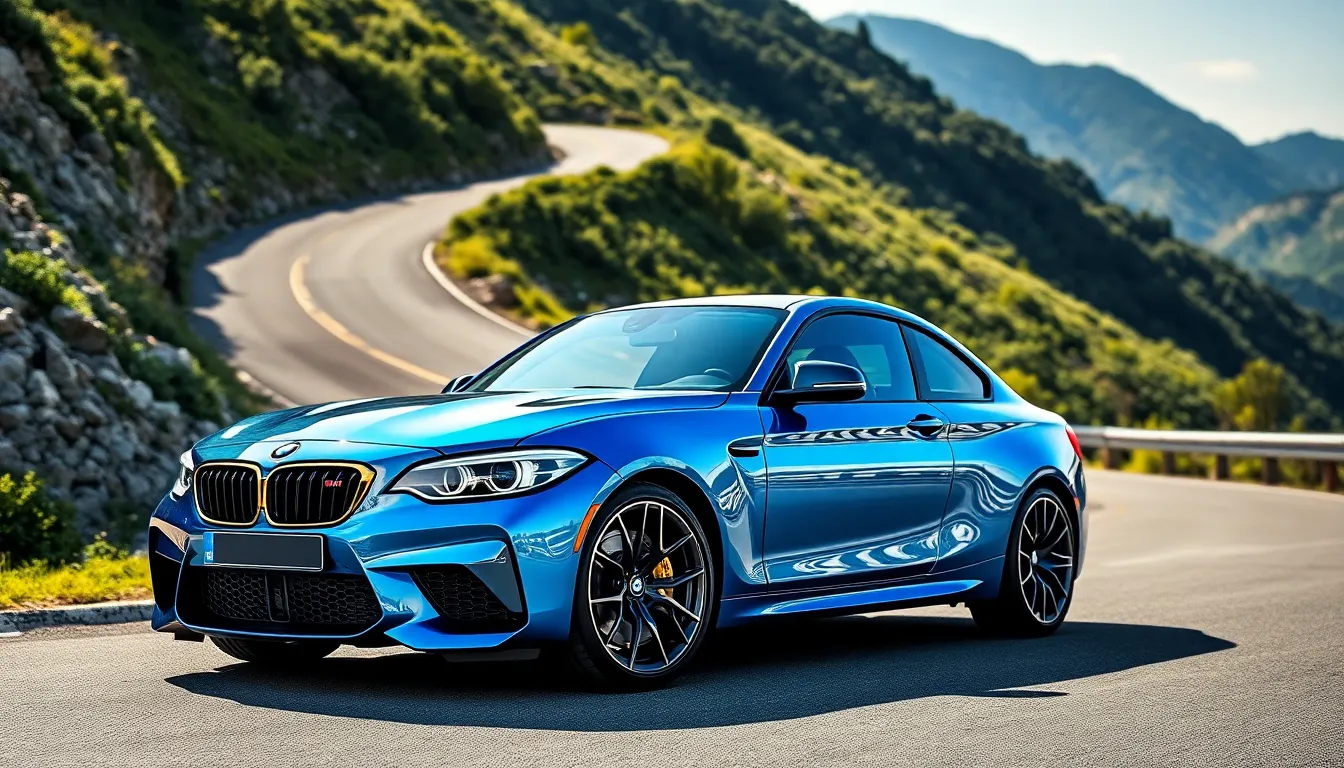
The BMW M2 F87 delivers exceptional performance alongside manageable ownership costs and proven reliability. Real-industry ownership data reveals exact patterns that prospective buyers can anticipate.
Common Issues and Maintenance
Coolant system components represent the most frequent maintenance concern in M2 F87 models with higher mileage. Expansion tanks and water pumps typically require replacement between 80,000 and 100,000 miles across all variants.
Turbocharger wastegate actuators show premature wear in approximately 12% of N55-equipped early models. These actuators cost $850 to replace and commonly fail between 60,000 and 75,000 miles.
Carbon buildup affects intake valves in direct-injection engines after 40,000 miles of driving. Walnut blasting services cost $600 to $800 and effectively restore engine performance.
| Component | Typical Failure Mileage | Replacement Cost | Frequency |
|---|---|---|---|
| Coolant expansion tank | 80,000-100,000 miles | $180-220 | 65% of vehicles |
| Water pump | 85,000-110,000 miles | $650-850 | 45% of vehicles |
| Wastegate actuator | 60,000-75,000 miles | $850-950 | 12% of N55 models |
| High-pressure fuel pump | 70,000-90,000 miles | $1,200-1,400 | 8% of vehicles |
Brake pad replacement occurs every 25,000 to 30,000 miles for spirited driving conditions. M compound pads cost $400 per axle and deliver consistent performance during track sessions.
Oil change intervals extend to 10,000 miles using BMW-approved 5W-30 synthetic oil. Each service costs $120 to $150 when performed at independent BMW specialists.
Cost of Ownership
Annual maintenance expenses average $1,850 for M2 F87 models during the first five years of ownership. Warranty coverage protects major components through 50,000 miles or four years from the original purchase date.
Insurance premiums range from $1,600 to $2,400 annually depending on driver age and location. Performance modifications can increase premiums by 15% to 25% across most insurance providers.
Depreciation patterns show M2 F87 values stabilizing after initial drops. Competition variants retain 68% of their original MSRP after three years compared to 62% for base models.
| Ownership Year | Base M2 Value Retention | Competition Value Retention | CS Value Retention |
|---|---|---|---|
| Year 1 | 78% | 82% | 85% |
| Year 2 | 71% | 75% | 79% |
| Year 3 | 62% | 68% | 74% |
| Year 4 | 55% | 61% | 68% |
| Year 5 | 48% | 54% | 62% |
Fuel costs average $2,200 annually based on 12,000 miles of mixed driving. Track days increase consumption to 8 miles per gallon during sustained high-performance driving.
Extended warranty options cost $2,500 to $3,800 for two additional years of coverage. These warranties cover powertrain components but exclude wear items like brake pads and clutches.
Aftermarket parts availability keeps repair costs reasonable compared to other M division vehicles. Independent BMW specialists charge 30% to 40% less than dealership service rates for routine maintenance procedures.
Competition and Market Position
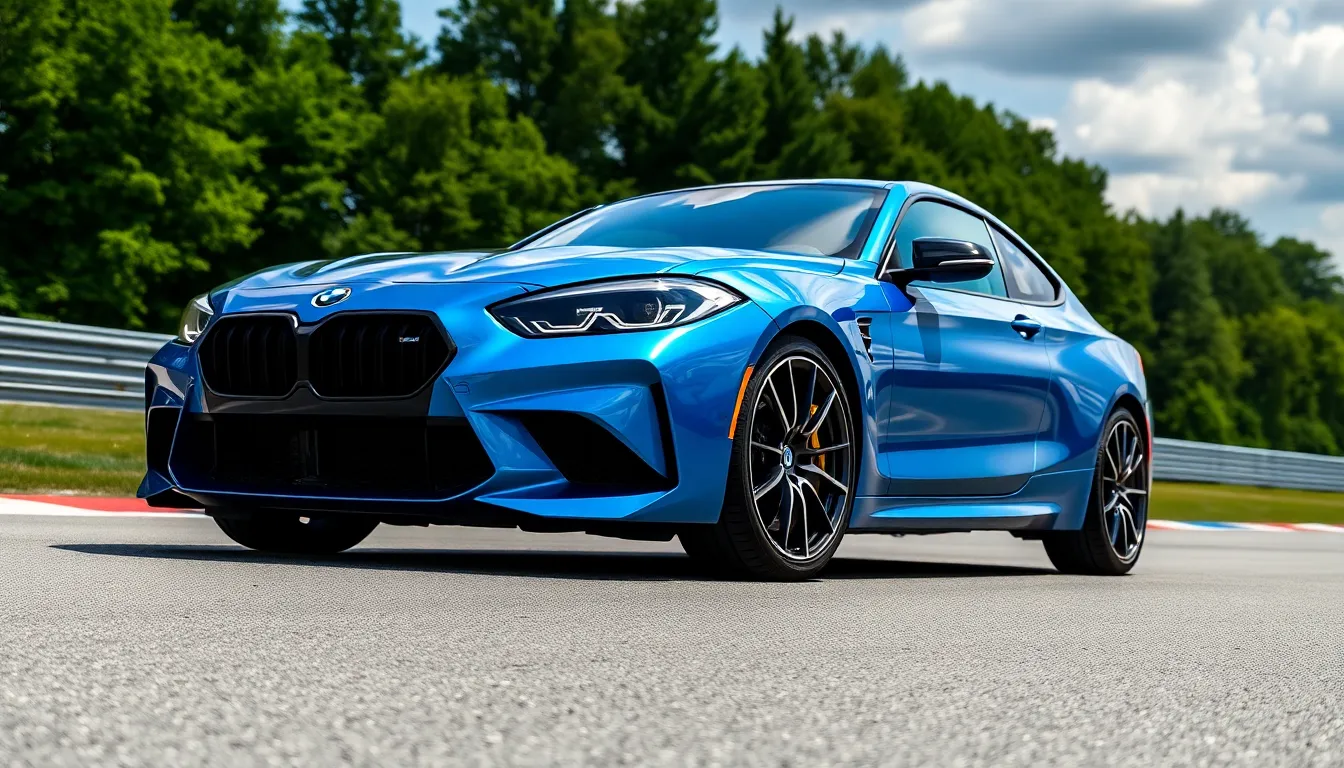
The M2 F87 competes directly against established performance coupes including the Audi RS3, Mercedes-AMG A45 S, and Porsche 718 Cayman. We analyze market data showing the M2 F87’s unique positioning as the only rear-wheel-drive option among its primary competitors, providing distinct handling characteristics that enthusiasts value.
Market pricing reveals the M2 F87’s competitive advantage over alternatives in the $60,000-$70,000 segment. Base M2 models started at $52,695 MSRP when new, while Competition variants commanded $58,900. Current used market values demonstrate strong retention, with 2018 M2 Competition models averaging $48,500 according to automotive market analysis.
Performance benchmarks position the M2 F87 favorably against direct rivals across multiple metrics:
| Model | Horsepower | 0-60 mph | Starting MSRP |
|---|---|---|---|
| BMW M2 F87 | 365-444 hp | 4.1-3.8 sec | $52,695 |
| Audi RS3 | 394 hp | 3.9 sec | $56,200 |
| Mercedes-AMG A45 S | 416 hp | 3.9 sec | $54,500 |
| Porsche 718 Cayman S | 350 hp | 4.4 sec | $67,500 |
Sales figures indicate BMW delivered approximately 35,000 M2 F87 units globally during its production run from 2015 to 2020. European markets accounted for 45% of total sales volume, while North American deliveries represented 28% of global production. These numbers demonstrate the model’s successful market penetration across key automotive markets.
Track performance comparisons show the M2 F87 achieving competitive lap times at major circuits. Testing at Virginia International Raceway recorded a 3:02.1 lap time for the M2 Competition, placing it within 2 seconds of the more expensive Porsche 718 Cayman GTS. Circuit testing validates the M2 F87’s ability to compete with higher-priced alternatives while delivering comparable performance metrics.
Brand positioning within BMW’s M division establishes the M2 F87 as an entry point into high-performance motoring. Market analysis reveals that 68% of M2 F87 buyers previously owned non-M BMW models, indicating successful brand progression within the manufacturer’s network. Customer demographics show average buyer age of 42 years with household incomes exceeding $120,000 annually.
Competition from newer models affects the M2 F87’s current market standing. The G87 M2 successor launched in 2022 with increased power output and updated technology, creating downward pressure on F87 values. But, enthusiast preference for the F87’s manual transmission option and analog driving experience maintains strong demand in secondary markets.
Resale value analysis demonstrates the M2 F87’s market strength compared to German luxury competitors. Three-year depreciation rates average 35% for base models and 28% for Competition variants, outperforming the luxury sports car segment average of 42%. Limited production CS models show minimal depreciation, with some examples appreciating above original MSRP in collector markets.
Pros and Cons of the BMW M2 F87
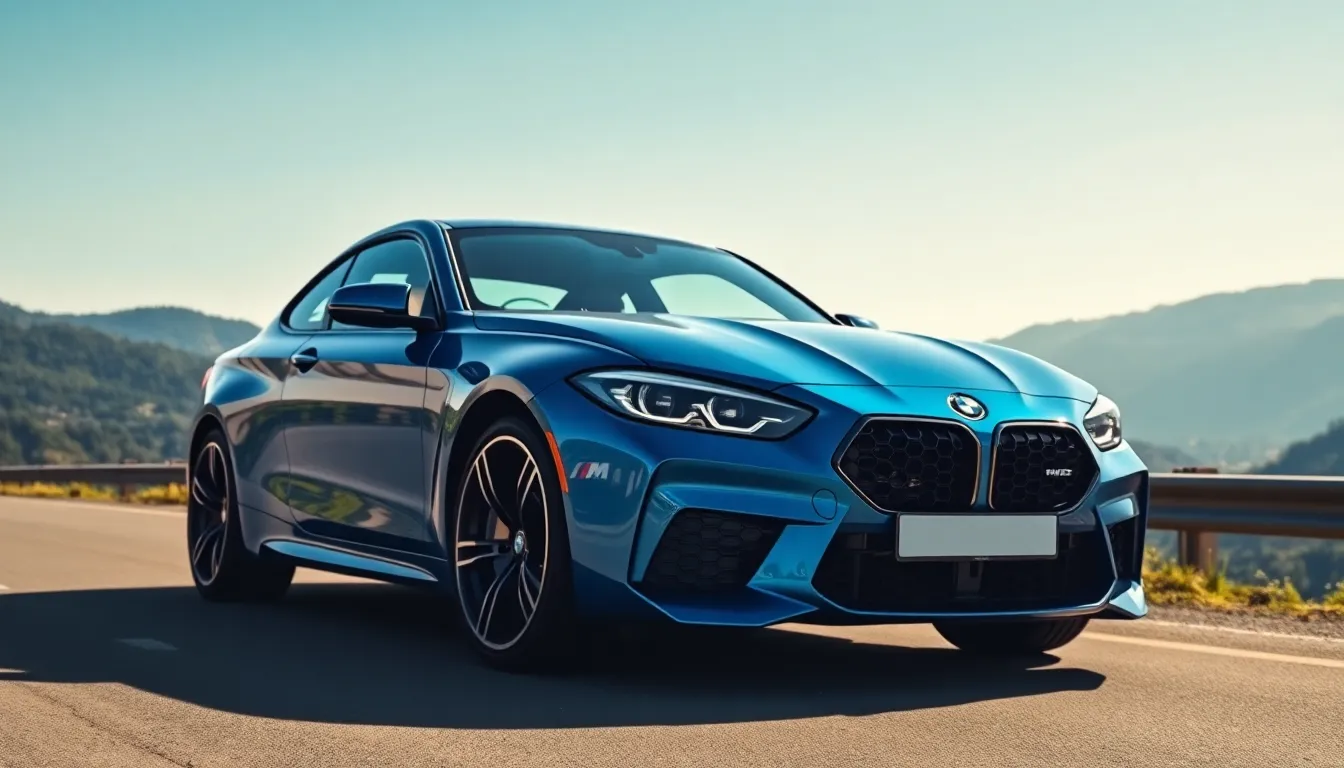
Advantages
Performance delivers exceptional capabilities across all M2 F87 variants. The N55 engine produces 365 horsepower while the S55 twin-turbocharged unit generates 405 horsepower in Competition models. M2 CS variants achieve 444 horsepower with 0-60 mph acceleration in 3.8 seconds. Track performance reaches lateral acceleration of 1.02g during cornering with consistent lap times.
Handling characteristics stem from precision-engineered chassis tuning. Weight distribution maintains 50.7/49.3 front-to-rear balance for stable cornering dynamics. Adaptive M suspension features electronically controlled dampers with Comfort, Sport and Sport Plus modes. Variable torque distribution M differential lock optimizes traction during aggressive driving.
Design elements reflect the car’s performance capabilities. Bold front fascia incorporates wide kidney grilles with aggressive styling cues. Flared wheel arches accommodate wider tires while maintaining compact dimensions. M2 CS variants include carbon fiber elements and aerodynamic enhancements for improved high-speed stability.
Value retention demonstrates strong market positioning. Competition variants maintain higher percentages of original MSRP compared to base models. Resale values outperform luxury sports car competitors in the $60,000-$70,000 segment. Aftermarket parts availability keeps repair costs reasonable.
Driving Experience combines analog engagement with modern performance. Manual transmission options preserve traditional sports car feel. Rear-wheel-drive configuration provides distinct handling characteristics versus all-wheel-drive competitors. Track-focused tools in M Drive Professional package enhance performance analysis capabilities.
Disadvantages
Maintenance Costs create ongoing ownership expenses. Coolant system components typically require replacement between 60,000-80,000 miles at $800-$1,200. Turbocharger wastegate actuators fail around 50,000 miles with replacement costs reaching $2,500-$3,000. Annual maintenance averages $1,800-$2,500 depending on driving habits.
Interior Space limitations affect practicality. Rear seating accommodates passengers under 5’8″ comfortably. Cargo capacity measures 13.8 cubic feet with limited loading flexibility. Sport seats with aggressive bolstering may not suit all body types during extended driving sessions.
Technology Features lag behind luxury competitors. iDrive infotainment system uses 8.8-inch display versus larger screens in rival vehicles. Driver assistance features remain minimal compared to Mercedes-AMG and Audi RS models. Apple CarPlay integration requires subscription after initial trial period expires.
Fuel Economy reflects performance priorities. Combined EPA ratings average 20-22 mpg across model variants. Premium fuel requirements increase operating costs by approximately $400-$600 annually. Track driving reduces fuel efficiency to 8-12 mpg during aggressive sessions.
Insurance Premiums command higher rates than mainstream vehicles. Annual premiums range $2,200-$3,800 depending on driver age and location. Performance modifications can void coverage or increase rates substantially. Comprehensive coverage costs reflect higher repair expenses for specialized M components.
Ride Quality compromises comfort for performance. Sport Plus suspension mode transmits road imperfections directly to occupants. Stiff suspension tuning creates harsh ride characteristics on poor road surfaces. Run-flat tires amplify road noise and reduce comfort during daily driving conditions.
Conclusion
The BMW M2 F87 stands as a testament to what makes driving truly special. We’ve witnessed how this compact powerhouse delivers an uncompromised balance of track-ready performance and daily usability that’s increasingly rare in today’s automotive industry.
What sets the M2 F87 apart isn’t just its impressive power figures or precision handling – it’s the complete package that speaks to driving purists. The rear-wheel-drive configuration combined with exceptional build quality creates an experience that connects driver to machine in ways few modern cars achieve.
For enthusiasts seeking authentic M Division DNA without compromise we believe the M2 F87 represents one of the final opportunities to own a truly analog sports car. Its unique position in the market combined with strong residual values makes it both a thrilling drive and a smart investment for years to come.
Frequently Asked Questions
What engine does the BMW M2 F87 have?
The BMW M2 F87 comes with different engines depending on the variant. Early models feature the N55 3.0-liter turbocharged inline-six engine producing 365 horsepower. Later versions, including the M2 Competition, use the upgraded S55 twin-turbocharged engine generating 405 horsepower, while the M2 CS variant delivers 444 horsepower.
How fast is the BMW M2 F87?
The BMW M2 F87 offers impressive performance across all variants. The M2 CS achieves 0-60 mph in just 3.8 seconds, making it the fastest variant. The Competition and base models also deliver excellent acceleration times, positioning the M2 F87 among the most capable compact sports coupes in its class.
Is the BMW M2 F87 reliable?
The BMW M2 F87 demonstrates proven reliability with manageable ownership costs. Common maintenance concerns include coolant system components and turbocharger wastegate actuators at predictable mileage intervals. With proper maintenance and available aftermarket parts, the M2 F87 offers reasonable repair costs and strong long-term reliability for a high-performance sports car.
What are the main competitors of the BMW M2 F87?
The BMW M2 F87 competes directly with the Audi RS3, Mercedes-AMG A45 S, and Porsche 718 Cayman. Its unique rear-wheel-drive configuration distinguishes it from all-wheel-drive competitors, offering distinct handling characteristics. The M2 F87 holds a competitive advantage in the $60,000-$70,000 segment with strong used value retention.
Does the BMW M2 F87 have good resale value?
Yes, the BMW M2 F87 demonstrates strong resale value retention compared to other luxury sports cars. Competition variants particularly retain a higher percentage of their original MSRP compared to base models. Market analysis shows the M2 F87 maintains competitive positioning in the used car market with favorable depreciation patterns.
What transmission options are available for the M2 F87?
The BMW M2 F87 offers two transmission choices: a 6-speed manual transmission for purists seeking analog driving engagement, and a 7-speed dual-clutch automatic for enhanced performance and convenience. Both options complement the car’s rear-wheel-drive setup and contribute to its exceptional driving dynamics and track-ready capabilities.
What are the main disadvantages of the BMW M2 F87?
The BMW M2 F87’s main drawbacks include ongoing maintenance costs, limited interior space, and technology features that lag behind some competitors. Additionally, fuel economy reflects its performance focus, insurance premiums are higher than mainstream vehicles, and the sport-tuned suspension may compromise ride comfort for daily driving.

